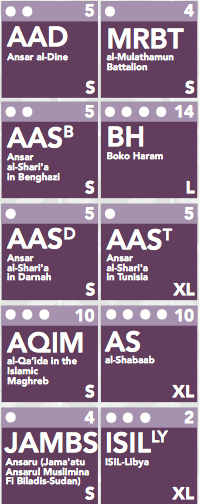Navanti updated its Periodic Table of Terrorist Groups to reflect the landscape of extremist organizations in 2017 across South America, Europe, Africa, the Middle East, Asia, and South Asia. The new periodic table can be found here. The most significant changes since the release of Navanti’s last periodic table in 2014 include the following:
Middle East
Addition of the Islamic State of Iraq and Syria (ISIL): ISIL came into the international spotlight in mid-2014 after taking over broad swathes of territory in Syria and Iraq. Over the next three years, ISIL fought a losing battle with Iraqi security forces and Popular Mobilization Forces on one side of the border, and the US-backed Syrian Democratic Forces on the other. While ISIL currently holds limited territory in both countries, members continue to plot attacks in the Middle East and abroad, including regional branches such as ISIL Sinai Province.

Addition of the Al-Nusra Front: Originally al-Qa’ida’s official branch in Syria, the Al-Nusra front broke off ties with its mother organization in summer 2016, although analysts dispute the nature and seriousness of that break. Current estimates place the number of al-Nusra fighters at between 5,000 and 10,000 individuals.
Expansion of Hizballah: The number of Hizballah fighters expanded since the latest periodic table release, from 5,000-10,000 fighters, to over 10,000 fighters.
Africa
Addition of Boko Haram: While Boko Haram was founded in 2002, the group rose to newfound prominence when it captured large amounts of territory in its home state of Borno in mid-2014. Boko Haram is currently classified as a large extremist organization with 2,500-5,000 members.

Addition of ISIL-Libya: Factions aligned with the Islamic Youth Shura Council pledged allegiance to ISIL in October 2014. In November of that year, ISIL leader Abu Bakr al-Baghdadi accepted the group’s pledge of allegiance. According to recent data, the group counts around 6,000 members and has carried out 490 attacks.
South Asia
Addition of al-Qa’ida in the Indian Subcontinent (AQIS): AQIS was formed in September 2014, following an announcement by Ayman al-Zawahiri, leader of al-Qa’ida. AQIS is listed as a medium-sized extremist organization, with 1,000-2,500 members, and is responsible for 28 attacks during the review period (2014-2017).
Addition of ISIL Khorasan: On January 2015, ISIL spokesman Abu Mohammed al-Adnani announced that ISIL had accepted a pledge of allegiance from extremist actors, several of whom were formerly in Tehrik-i-Taliban Pakistan. The group operates in the historical Khorasan region that includes parts of Afghanistan and Pakistan. ISIL Khorasan is listed as a medium-sized extremist organization, with 1,000-2,500 members, and is responsible for 196 attacks during the review period (2014-2017).

